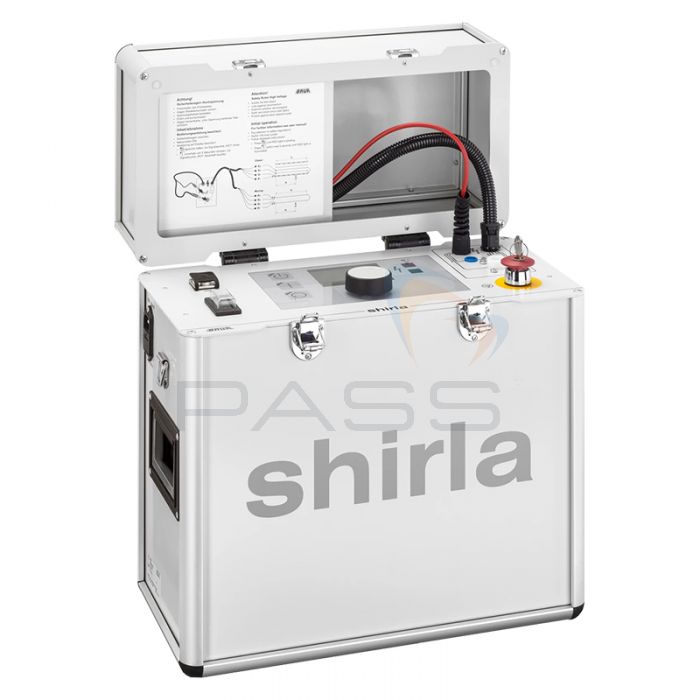BAUR Shirla Cable Sheath Fault Locator

- Pre-locate and pin-point cable sheath faults/ cable faults caused by earth contact
- Measure insulation resistance
- Generate pulsed voltage up to 10kV
The BAUR Shirla Cable Sheath Fault Locator can be used to pre-locate and pin-point cable sheath faults and cable faults caused by earth contact. It can also be used to measure insulation resistance. The BAUR Shirla is a mobile unit that can be powered via a mains supply or battery.
The BAUR Shirla Cable Sheath Fault Locator utilises the bridge principle according to Murray and Glaser for fault pre-location. This method is optimised for power cables but can be used for control and lightning cables. The fault distance is indicated in metres; the user can enter cable sections to improve the accuracy of the fault distance measurement. Cable sections according to length, conductor cross-section, and material can be entered into the BAUR Shirla Cable Sheath Fault Locator. Zero balance and evaluation are conducted automatically.
Generation of a pulsed voltage enables the operator to utilise the step voltage method when fault pin-pointing. The BAUR Shirla Cable Sheath Fault Locator can generate pulsed voltages up to 10kV and includes four selectable pulse patterns as well as an adjustable switch-on delay and operating time. It can be used with the Baur KMF 1 Earth Fault Locator or UL30 Universal Receiver to locate cable sheath faults and faults caused by earth contact quickly and accurately.
The BAUR Shirla Cable Sheath Fault Locator features adjustable voltage and current limitations and supports automatic measurement sequences and reporting. It will automatically export data to a USB stick or via a USB interface. The BAUR Shirla Cable Sheath Fault Locator’s intuitive interface ensures that it is simple to operate.
This mobile cable sheath tester and fault locator also includes an integrated discharge unit and a connection for an emergency off unit ensuring the BAUR Shirla Cable Sheath Fault Locator is in accordance with EN 50191.
The BAUR Shirla Cable Sheath Fault Locator is a mobile, simple-to-operate, precise cable fault locator.
BAUR Shirla Cable Sheath Fault Locator Key Features
- Pre-locate and pin-point cable sheath faults and cable faults caused by earth contact
- Measure insulation resistance
- Mobile unit that can be powered by a mains supply or battery
- Conducts fault pre-location using the bridge principle according to Murray and Glaser
- Optimised for power cables but can be used on control and lightning cables
- Fault distance is indicated in metres
- Enter cable sections according to length, conductor cross-section and material to improve the accuracy of fault pre-location measurements
- Automatic zero balance
- Automatic evaluation
- Step voltage method used for fault pin-pointing
- Generates pulsed voltage up to 10kV
- Four selectable pulse patterns
- Adjustable switch-on delay and operating time
- Use with the KMF 1 Earth Fault Locator or UL 30 Universal Receiver to locate cable faults
- Adjustable voltage and current limitations
- Supports automatic measurement sequences and reporting
- Automatically exports data to a USB stick or via a USB interface
- Intuitive interface
- Simple to operate
- Integrated discharge unit
- Connection for an emergency off unit ensuring compliance with EN 50191
- A mobile, simple-to-operate, precise cable fault locator
What’s Included?
- Baur Shirla Cable Sheath Fault Locator
- HV Connection Cable, 4.5m, Fix Mounted
- 4-Wire Bridge Connection Cable, 2.5m, Fix Mounted
- G Clamps, 24mm, 4pcs
- Short Circuit Cable Set
- Earth Cable, 3m, with Earth Terminal
- Transport Case for Accessories
- USB Memory Stick
- Mains Supply Cord, 2.5m
- Carrying Strap
- User Manual
BAUR Shirla Sheath Cable Sheath Fault Locator Technical Specifications
| Cable and Cable Sheath Testing | |
| DC voltage | 0 – 10 kV |
| Output current | 10 mA @ DC 5 kV |
| 5 mA @ DC 10 kV | |
| Current indicator | Accuracy ± 10 µA |
| Resolution 1 µA | |
| Insulation resistance measurement | 0.01 megohm to 1 gigaohm |
| Voltage and current limitation | adjustable |
| Measuring bridge (pre-location of cable sheath faults and faults due to earth contact) | |
| Measurement method | 4-wire measuring bridge according to Murray and Glaser |
| Output voltage | DC 100 V – 10 kV |
| Max. output current | 50 mA |
| Accuracy | Accuracy 0.1% relating to the measurement result |
| Number of definable cable sections | 50 |
| Voltage and current limitation | adjustable |
| Step Voltage Method (cable sheath fault pin-pointing) | |
| Pulsed DC voltage | 100 V – 10 kV |
| 4 selectable pulse patterns | |
| Max. output current | 700 mA |
| General | |
| Display |
LCD with background lighting, screen resolution 320 x 240 pixels Automatic brightness setting |
| Reporting | Shown on display |
| Automatic export via USB interface (USB 2.0) |
|
| Data export format | Text file, bilingual: English, German |
| Power supply | Mains voltage AC 100 – 240 V, 50/60 Hz |
| Rechargeable battery DC 12 V; 3.4 Ah | |
| Max. power consumption | 200 VA |
| Ambient temperature (operational) | -20°C to +50°C |
| Storage temperature | -40°C to +60°C |
| Relative humidity | Non-condensing |
| Dimensions (W x H x D) | Approx. 440 x 490 x 220 mm |
| Weight incl. accessories | Approx. 20 kg |
| Degree of protection | IP54 (in closed state) |
| Safety and EMC | CE-compliant in accordance with Low Voltage Directive (2014/35/EU),EMC Directive (2014/30/EU), EN 60068-2-ff Environmental testing |
| Integrated Battery | |
| Battery type | Lead-acid battery 12 V, 3.4 Ah |
| Battery life | Approx. 45 min (in HV mode) |
| Charging time | Approx. 4 h |



